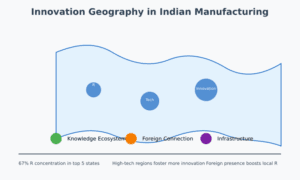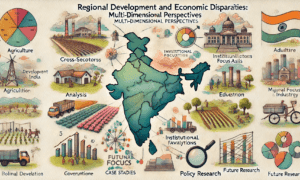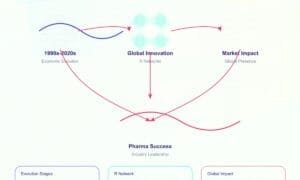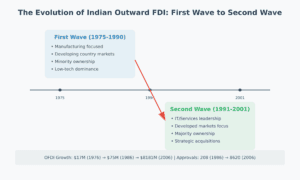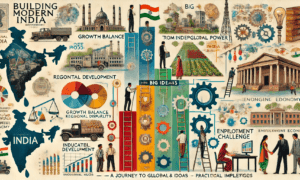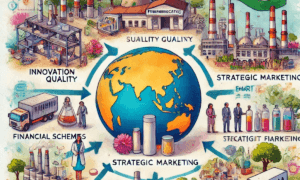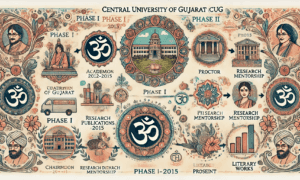A fascinating study reveals how Indian automotive companies are using international expansion to drive innovation at home
When companies expand internationally, who learns from whom? The conventional wisdom suggests that when companies from developing countries invest abroad, they’re mainly there to learn from more advanced markets. But new research on India’s automotive sector tells a more nuanced story of two-way knowledge exchange that’s helping to accelerate innovation.
The Rise of India’s Global Auto Players
India’s automotive industry has transformed from a protected domestic market into a global powerhouse. Local companies like Tata Motors and Mahindra & Mahindra aren’t just exporting vehicles and parts – they’re setting up factories, forming partnerships, and acquiring companies around the world. This global expansion takes two main forms:
- Building from Scratch: Setting up new overseas facilities (greenfield investments)
- Strategic Acquisitions: Buying existing foreign companies (brownfield investments)
A Two-Way Street of Learning
The research reveals that when Indian auto companies invest abroad, knowledge flows in both directions:
What Foreign Markets Learn from India
- Cost-effective manufacturing techniques
- Frugal engineering approaches
- Skills in developing market-appropriate vehicles
- Quality management systems in developing country set up
- Process innovations
What Indian Companies Gain
- Access to advanced technologies
- Exposure to cutting-edge R&D
- Understanding of mature market customer preferences
- Global quality and safety standards
- Modern management practices
The Numbers Tell the Story
The study found compelling evidence that overseas expansion drives innovation back home:
- Companies with international operations invest more in R&D
- The effect is strongest when investing in developed markets
- Both wholly-owned subsidiaries and joint ventures show positive impacts
- The benefits increase with the scale of international investment
Where Geography Matters
While Indian auto companies benefit from investing in both developed and developing markets, the research shows some interesting patterns:
Developed Markets
- Generate stronger R&D benefits
- Provide access to cutting-edge technology
- Offer exposure to stringent regulations
- Help build global brand credibility
Developing Markets
- Allow testing of new capabilities
- Provide similar market conditions
- Enable regional expansion
- Offer manufacturing cost advantages
Key Success Factors
The study identifies several factors that help companies maximize learning from international expansion:
- Absorptive Capacity: Having sufficient in-house R&D capabilities to understand and adapt new knowledge
- Strategic Intent: Clear goals for what knowledge to acquire
- Local Partnerships: Working with local firms can accelerate learning
- Scale of Investment: Larger investments tend to generate more knowledge transfer
- Management Commitment: Long-term view of learning and capability building
Looking Ahead: Policy Implications
The research suggests several policy recommendations:
For Companies:
- View international expansion as a learning opportunity
- Invest in domestic R&D to better absorb foreign knowledge
- Consider strategic partnerships in key markets
- Take a long-term view of capability building
For Policymakers:
- Support outward investment in strategic sectors
- Help companies identify overseas opportunities
- Provide financial incentives for R&D investments
- Facilitate international technology partnerships
Conclusion
The globalization of India’s automotive sector offers valuable lessons about how companies from emerging markets can use international expansion to build innovation capabilities. Rather than a one-way transfer of knowledge, we’re seeing a rich exchange that benefits both sides. As more companies from developing countries go global, this pattern of mutual learning could reshape how we think about innovation in the global economy.
Published Source: Pradhan, Jaya Prakash and Neelam Singh (2009), ‘Outward FDI and Knowledge Flows: A Study of the Indian Automotive Sector’, International Journal of Institutions and Economies, 1(1), pp. 155–186, 2009, Publisher: University of Malaya.
Academic Abstract:
In recent years developing countries have emerged as significant participants in the OFDI (outward foreign direct investment), seeking strategic assets. Such asset exploiting-cum-augmenting OFDI involves potential two-way cross-border knowledge flows. This study examines several dimensions of OFDI in the Indian automotive industry – currently internationalizing rapidly in terms of OFDI. This study undertakes a quantitative analysis of the influence of OFDI activities on the in-house (domestic) R&D performance of the Indian automotive firms during 1988-2008, and finds expected favourable impact on the R&D intensity. The study concludes with suggestions to promote OFDI, particularly the strategic asset enhancing OFDI.
Learn More:






